Below is a presentation that I gave to the Royal College of Nursing, Australia (RCNA) conference in Cairns on Friday, May 25, canvassing the implications of the digital revolution for healthcare, media and society more broadly. If you’d like to comment/critique, please do so at the bottom of the post or email me direct.
***
The media and healthcare industries: what does the digital revolution mean for us?
Last Friday (May 18), I headed to the SWF, which is one of my favourite events of the year, not least because of the beautiful venue, on the old wharves by Sydney Harbour.
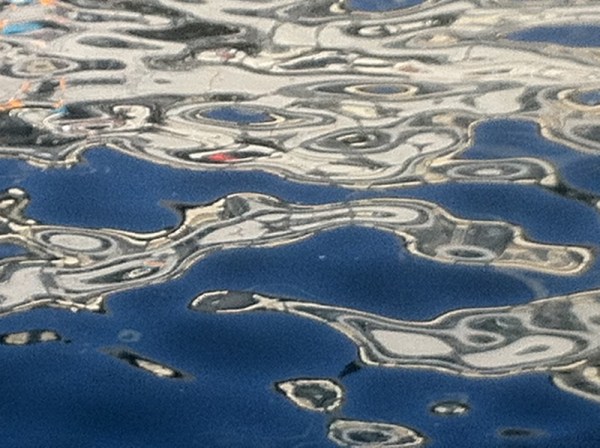
Also heading to the festival last Friday was this person: a journalism professor/blogger/futurist.

If you’ve read his books, you will also know him as an optimist, idealist and enthusiast for the online revolution (and I’d put myself into those categories too).
Note how many followers he has – almost 100,000, ie he has more subscribers than some mass media publications.
But just to put that into perspective…

Bieber has more than 22 MILLION followers (Stephen Fry has a mere 4.3 million)
Nonetheless, because Jarvis is so well connected, it means that when he sent out this note, he was guaranteed of a party (TWIG is one of a number of platforms enabling open meetings).
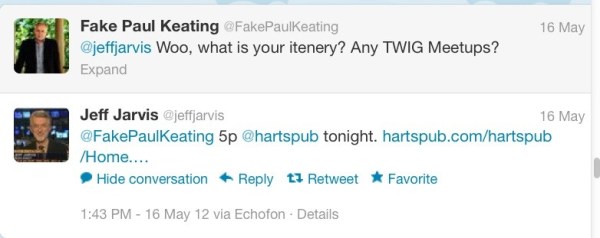
By engaging with the wider community in this way, Jarvis was opening himself up to discussions and learnings from people he didn’t know about (even the Fake Paul Keating).
Jarvis published this book in 2009, and his most recent book is Public Parts: How sharing in the digital age improves the way we work and live.
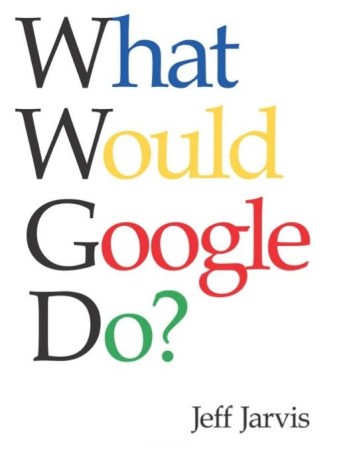
WWGD is a play on bumper stickers which apparently are common in the US: WWJD – What Would Jesus Do?
Jarvis says the idea behind the book is:
“I try to reverse-engineer the success of the fastest growing company in the history of the world, the one company that truly understands how to succeed in the internet age, and then take those lessons and apply them to a number of industries, companies, and institutions, from carmakers to restaurants to universities to government.”
Another foreward thinking author Chris Anderson says on the blurb:
“Google is not just a company, it is an entirely new way of thinking. Jarvis has done something really important: extend that approach to business and culture, revealing just how revolutionary it is.”
You learn a lot about Jeff Jarvis as a person and a professional from his books. It is telling that the journey that led to WWGD began with his foray into blogging, after being personally affected by the Sept 11 attacks on New York.
He discovered that blogging was a very different experience to anything he’d done previously as a journalist – because it was a multi-way exchange, rather than him just broadcasting as journalists have traditionally done, and because he began to realise the power of networks, connections and the internet.
These are lessons which also have implications for the healthcare sector. The digital revolution is affecting all aspects of society – institutions and organisations, governments, services, businesses and citizens.
The media and the healthcare industries have much to learn about this from each other, as we have more in common than many might assume. I have often seen parallels between your industry – healthcare – and mine – the media. And there are also some shared lessons for us out of the digital revolution.
What do the media and healthcare industries have in common?

I chose this picture – not just because of its obvious symbolism, of a crumbling out-of-date fortress – but because we have free access to it as part of creative commons publishing via the photo sharing service Flickr – which again gets quite a lot of attention from Jarvis in his books as an example of the benefits of the public’s willingness to create and to share.
Healthcare and the media are both powerful institutions, rooted in hierarchies, and a command and control model. Those of us working in these industries have much more power than those we are meant to serve – although we often complain about feeling powerless.
And our own industry’s interests can get put ahead of the public interest.
As the fortress image suggests, we have traditionally expected our audiences to come to us – visit our service, buy our newspaper or magazine, rather than taking the Google approach to distribution – ie going to where your communities are and using them to create and distribute on your behalf.
What else do we have in common? Both industries involve fragmented processes and have not traditionally been designed or structured for openness or participation by those we are meant to serve.
Both industries are perfectly designed to get the results that we do: in other words there is great potential for things to go wrong. And yet we have traditionally been extremely defensive about this.
We in the media are on shaky ground if we critique the long and tortuous process it’s taken to make open disclosure happen in health services, given media organisations’ reluctance to acknowledge their mistakes.
Both industries involve strict demarcations between professional roles. Forget about the fight between the AMA and the Pharmacy Guild, or the medical resistance to expanded nursing roles. In my business, we have been brought up to define our roles very tightly. There are still those who say: I am a journalist who writes news stories for a newspaper – I don’t do audio or video or take photos. And heaven forbid that anyone might suggest that I work with non-journalists or do community engagement as part of my professional role.
Those have been the traditional attitudes although they are changing.
Both the healthcare and media industries are enormously resistant to change. We are not famous as innovators.
Of course, these are sweeping generalisations. There will be many individuals and organisations in both of our sectors that do not fit these characterisations.
But as a general rule…
So that’s what we have traditionally had in common. What might we also have in common as the digital revolution challenges and confronts both of our industries?
What are the new opportunities for both industries?
1. The digital revolution gives us opportunity to do things very differently – and to fundamentally re-evaluate our purpose
Much of Jarvis’ book is about the ability of the Internet to lead to efficient self organisation – eg developing and maintaining communities of interest. He writes (p 237):
“Generation G will be able to organise without organisations. That ability to coalesce will have a profound destablising impact on institutions. We can organize bypassing governments, borders, political parties, companies, academic institutions, religious groups and ethjnic groups, inevitably reducing their power on our lives….One no longer need control institutions to control agendas. The internet is fueling the rise of the third estate – the rise of the people. That might bode anarchy except that the internet also brings the power to organise.”
And this (p53):
“We also have new ethics and attitudes that spring from this new organization and change society in ways that we cannot yet see, with openness, generosity, collaboration, efficiency. We are using the Internet’s connective tissue to leap over borders – whether they surround countries or companies or demographics.”
What are the new opportunities for both industries?
2. The digital revolution challenges us to listen to feedback and to engage with our communities
This recent article in the Huffington Post by its Washington bureau chief Dan Froomkin gives advice for how journalists can reconnect with their audiences in the digital age – but many of the general themes might be equally useful for other industries.
One of the tips is to “unleash our readers’ voices“. Froomkin writes:
“In addition to collecting readers around our voices, we should make sure our readers can find theirs, too. And when they are saying something worthwhile, we should make sure our readers are heard, as well. To that end, we should move aggressively to adopt best practices in mass Internet participation. Our goal should be a system that allows good ideas, relevant personal stories, informed opinions and perhaps even consensus on some issues to bubble up to the surface — and even into our reportage.”
Try substituting patients, or communities, or citizens for “readers”. It still works.
The title of the article – Playing it ‘safe’ is killing the American newspaper – is also relevant to health care – where so much of the discussion around the impact of social media and the digital revolution has been about playing it safe, or risk management, rather than seizing the opportunities.
What are the new opportunities for both industries?
3. The digital revolution also challenges us to be more transparent
If you go to the disclosures section on Jarvis’ website, he has an amazing amount of detail about his associations, not only his work and financial interests but even his religious background and how he votes.
He says:
I am a liberal: a centrist leaning left. I have voted for Democrats in most elections. In the 2008 primary, I voted for Hillary Clinton. In the general election, I voted for Barack Obama. Nonetheless, I piss off Democrats for not always agreeing with them and for linking to those with whom they disagree. But that is why I like the blogosphere so much: because I end up talking with people whose opinions often don’t align with mine.
This is a level of disclosure rarely seen from journalists – and certainly not from health services or professionals, although the launch of initiatives such as MyHospitals is a sign of a broader international push to increased transparency and accountability. But so much more could be done.
- Would you like to know, for eg, if a specialist you are seeing has received funds from a pharma or devices company related to promotion of a treatment that is being recommended for you?
- Would you like to know if funds allocated to your service for mental health are being siphoned off to surgery or emergency departments?
- Would you like to know if your part of the city gets far fewer health dollars than another, more privileged part of the city (which also just happens to be where the specialists tend to congregate)?
- How might your organisations become more transparent, not only to their patients and communities, but also to their employees?
Transparency, as Jarvis notes, is important for trust (p83):
Trust is more of a two-way exchange than most people – especially those in power – realize. Leaders in government, news media, corporations and universities think they and their institutions can own trust when, of course, trust is given to them. Trust is earned with difficulty and lost with ease. When those institutions treat constituents like masses of fools, children, miscreants, or prisoners – when they simply don’t listen – it’s unlikely they will engender warm feelings of mutual respect. Trust is an act of opening up; it’s a mutual relationship of transparency and sharing. The more ways you find to reveal yourself and listen to others, the more you will build trust, which is your brand.
On a similar note, he says (p90):
Corrections do not diminish credibility. Corrections enhance credibility. Standing up and admitting your errors makes you more believable; it gives your audience faith that you will right your future wrongs.
What are some of the opportunities for nurses from the digital age?
There are more opportunities than ever before to engage in public debate – to create digital content, to comment and join discussions, and to source useful health content, eg:
- MJA Insight
- 6 Minutes
- The Drum
- Crikey and associated blogs eg Croakey
- Inside Story
- Australian Policy Online (one of my faves – if you haven’t already signed up, then do so)
- ABC Open
- New Matilda
- On Line Opinion
- The Conversation
- The Global Mail
The Conversation and The Global Mail are highlighted in bold because, unlike most of the digital newbies, they have serious cash behind them. Sustainability remains an ongoing challenge for most of the new outfits.
The blogsophere also offers new opportunities for nurses to create, contribute and engage (and not only with nursing blogs, I might add).

Croakey is an example of digital media innovation which offers new opportunities for nurses to engage in public debate – for example, in cross-publishing articles.
As the digital revolution blurs roles and boundaries, there are increasingly examples of media innovation that could also been seen as a health intervention (and vice versa).
The recent Sydney Morning Herald initiative around drug law reform – which has involved both old-fashioned community engagement, via a public meeting, and online participation – is one such example (see #drugdilemma for some of the Twittersphere chat).
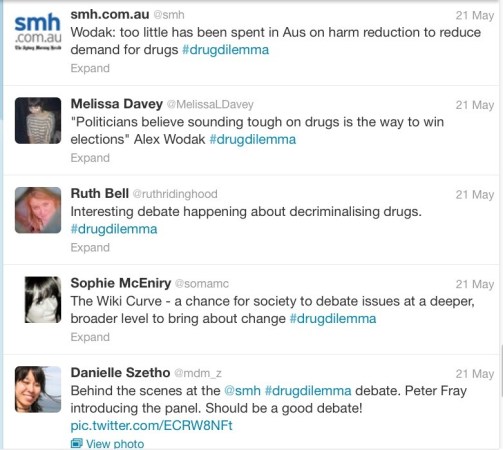
Another – and much more interesting example of online media/health innovation – is the launch by the US not-for-profit investigative outfit, ProPublica, of a Facebook community for patients who have been harmed by healthcare. It is also open to others concerned about this issue, including health professionals, regulators and service managers – and other journalists (as profiled in this recent Croakey post).
These are fertile times – the ease and speed with which ideas can be exchanged, debated, advanced is unprecedented.
Jarvis quotes science journalist Matt Ridley thus: “Ideas are having sex with each other as never before”. Ridley argues that “what determines the inventiveness and rate of cultural change of a population is the amount of interactions between individuals.”
On a similar note, a London School of Economic blog recently stated that:
“Blogging is quite simply, one of the most important things that an academic should be doing right now”.
“Academic blogging gets your work and research out to a potentially massive audience at very, very low cost and relative amount of effort.”
We are all publishers now…
Given how prickly journalists have sometimes been about the perceived encroachment into their turf by bloggers – “others” – it is noteworthy that the comments in these tweets below were made at a recent journalism conference. But they also speak to this audience and how the roles of you and your colleagues and your organisations are being redefined.
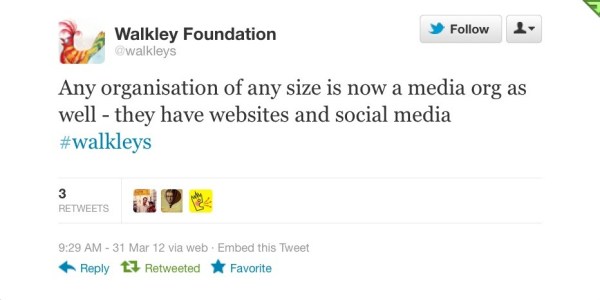
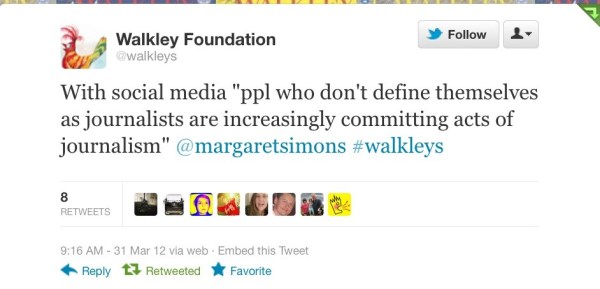
Health Workforce Australia has been a relatively early adopter of the mantra that “everyone’s a publisher now”, using YouTube to communicate directly with the community about its complex work agenda.
In this clip, HWA CEO Mark Cormack explains a new project to develop a nationally consistant approach to prescribing by non-doctors, and speaks of the need for reform in nurse training, to improve nurse retention, and to make flexible use of skilled workforce. He also says the agency is about to launch a new E-newsletter, and announces HWA’s inaugural conference – in Melbourne on 12-14 November.
[youtube]https://www.youtube.com/watch?v=ygLxNqtEX5M[/youtube]
On a related note, YouTube recently announced that its video uploads grew by 50 percent over the last year. Users are now uploading 72 hours of video every minute, compared to 48 hours just a year ago.
Health services and organisations could be making much wider use of platforms like YouTube.
Those who are interested in influencing policy and exerting influence should also read this recent article about the benefits of social media for health leaders, by Daryl Sadgrove, CEO of the Australasian College of Health Service Management. He says:
Leadership is about influence. Social media is like an influence amplifier. I think social media is one of the most powerful tools ever given to a healthcare leader, it enables you to extend your influence in ways never before possible.
More opportunities for nurses (and others) from the digital age
It is easier to find out about under-served issues and areas of need, as per this MSF article below.

Social media enables relationships to be created, extended and enriched – both with colleagues and those you serve.
As Jarvis writes (p 23):
The single greatest transformative power of the internet and Google has little to do with technology or media or even business. It’s about people and making new connections among them. It all comes back to relationships.
Social media enables innovation and service redesign.
As Jarvis writes about the general concept of design (p 116):
Design is an ethic. Design is the path by which you interact with your public. Magazines, clothes, and cars aren’t the only things that are designed. Companies are designed. Services are designed. Rules are designed. The simpler and clearer the design, the better. To be simple is to be direct. To be direct is to be honest. To be honest is to be human. To be human is to be in a conversation. To be in a conversation is to collaborate. To collaborate is to hand over control. And we are back to where we started, to Jarvis’ First Law: Give the people ontrol and we will use it. Don’t and you will lose us. Simple.
Meanwhile, at the World Health Organization’s 65th World Health Assembly in Geneva this week, the Director-General, Dr Margaret Chan, spoke of the need globally for “frugal innovation”. She said:
… as public expectations rise, costs soar, and budgets shrink, we must look to innovation as never before. And I mean the right kind of innovation. Innovation does the most good when it responds to societal concerns and needs, and not just to the prospects of making a profit.
These days, the true genius of innovation resides in simplicity.
This is not rocket science. This is frugal, strategic innovation that sets out to develop a game-changing intervention, and makes ease of use and affordable price explicit objectives.
One way for doing “frugal innovation” is to harness the gift economy and the wisdom of the crowd – via crowdsourcing.
Below is an example of crowdsourcing support for social change – it could also be see as an example of using creative endeavours to advance public health discussions and objectives.
There are now many platforms to enable crowdsourcing of funding and ideas for creative and other projects. This is one effort to crowdsource funds to do a docco based on the landmark book, The Spirit Level, which analysed 25 years of research to show how a more equal society is better for all of us, including the rich. It shows how nearly all social ills – stress, poor educational performance, high crime rates, unwanted teenage pregnancies – are more common in those societies with a big gap between rich and poor.
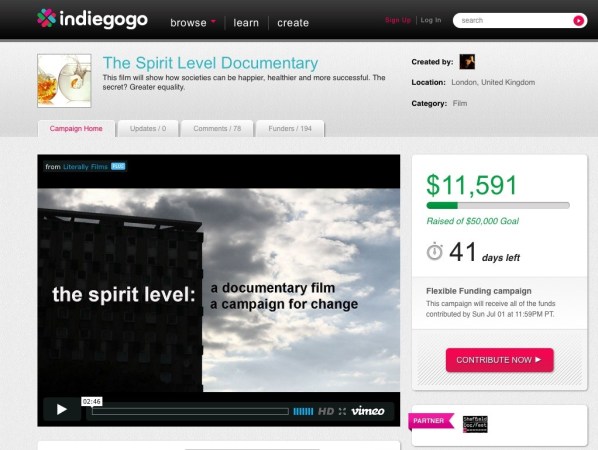
This audience might like the pitch: “This is your chance: the film which will change the political debate and make the world a better place. Its message: equality works. Tax the bankers, cut the pay of the people at the top and pay more to the nurses, the cleaners, the McDonald’s worker, the supermarket check-out staff, (well, let’s be frank – 90% of us) and the world will be a happier place, the economy will be more successful and we will live longer.”
Perhaps Gina Reinhart, the world’s richest woman, might like to pitch in some of the estimated $52 million she earns a day.
But, as the pitch notes, “it’s not all about money”…. , “whether you can support us financially or not you can help us by spreading the word via facebook, twitter and blogs. This film is about a movement and a campaign, and by participating, you can help make it happen. Together, we can do for public understanding of inequality what An Inconvenient Truth did for the public understanding of climate change.”
The pitch goes onto suggest how supporters can use a range of social media to generate support for the project.
There are many lessons and applications from this pitch and the broader use of online crowdsourcing for the healthcare sector – including the potential of engaging your community in helping to do your work.
Twitter offers rich pickings on the social determinants of health
On similar themes, Twitter sent a link to this JAMA series on global health this week, which included an article from Sir Michael Marmot urging that:
…health equity should be at the heart of all policy making, national and global.
The social determinants of health is not an easy issue in which to engage mainstream media and politicians. But it is the subject of a vibrant lively discussion on Twitter and much sharing of useful resources and developments. If this is an issue close to your heart, you need to be on Twitter.
The pace of change and development in health and social media is overwhelming. Every day many interesting new articles about use of the various forms – Twitter, Pinterest, facebook – in research, clinical practice, policy development, advocacy, and public health.
Just before I came here this afternoon, I posted an article that referred to a conference in Sydney today on social media and health, a blog by a NZ nurse and midwife who is using social media in her work, and a new blog for doctors working in Indigenous health.
This recent Huffington Post story about how the WHO is using social media to manage global health crises is well worth reading.
It quotes a WHO staffer saying:
Social media are more mainstream than ever. News is breaking on Twitter. Citizen journalism is becoming as valuable as paid journalism. Clicktivism is a new way of campaigning for many causes. Social media become a new bridge that connects people. WHO talks to a broad range of people on our social media channels: Everyone from a ministry of health official to the parents of a premature baby.
WHO now has two full-time social media staff. It gets nearly 6,000 new followers on Twitter per week and about the same number on Facebook per month. And these numbers are growing.
“Most importantly, people pass on our messages to their circles of friends, comment and ask follow-up questions,” says the staffer. “They create conversations among themselves based on our tweets or posts on Facebook. These are not just numbers, but real people who are actually having conversations with WHO. These are our public health ambassadors in this digital era.”
Which prompts me to wonder – who are the digital ambassadors for nursing? For your health service or organisation? For your professional area of interest?
Making sense of the social media noise
When I put out a call via Croakey recently for ideas for new online health publications, a fabulous suggestion came from Malcolm Lewis, self-described as a “public health 2.0 innovator/catalyst”.
He suggested a publication called “Health2.0 Blur” – except his idea was about far more than publishing.
It’s worth reading his pitch in full but here is an extract:
New technologies for communication, learning, research, coordination, epidemiology such as the full range of new media from webinars, through Youtube to Twitter, from tablets & smartphones, to NBN, and PCEHR are transforming what is possible in health. New tech offers new models of service delivery in every area of health from education, to research through to service delivery and evaluation.
We need a new type of web20 multimedia publication to help us cope with this revolution. It is all changing so fast and we need help in making sense. We need to support learning and conversations to help us nut a way through all this tech-driven disruptive change.
The groups we need to bring into a conversation: Managers, health innovators, tech types, Health Care Professionals of all types, early adopters, education researchers, policy, health public affairs, pharma, people in health sector who use social media in personal life and want guidance to use it in their professional life. Patients need to be in the conversation as well.
It needs to be more than a web based publication, It needs to be a learning community. Its needs to be Multimedia: Webinars, podcasts, video casts, use guest bloggers, twitter chats, Linkedin discussion groups, Facebook, use aggregation software to bring all the threads together, like https://grsshopper.downes.ca/
It will be some journalism, some community facilitation, some content curation and totally amazing (my emphasis).
Digital media transformation: what else might help?
Of course the health sector needs tools and skills like these resources from the CDC. It also needs to dedicate resources to exploring and exploiting the potential of social media.
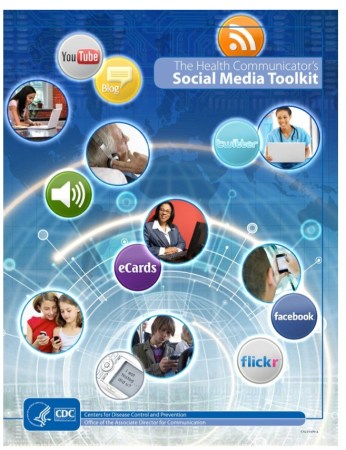
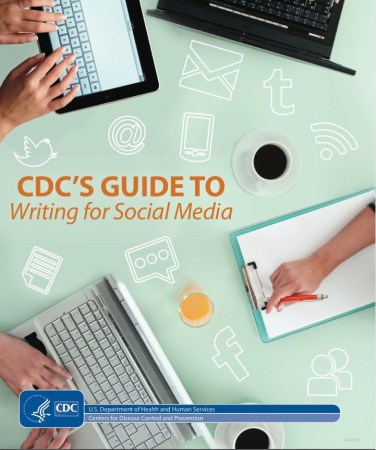
But most importantly, the sector needs organisational and cultural change because….
The revolution is on hold
A survey recently conducted by the good people behind the Life In The Fastlane blog investigated how many public and private hospitals are using social media and social networking infrastructure to assist the public in providing accurate basic contact details, health resources and the potential for a 2-way conversational feedback loop to enhance the quality assurance cycle.
The researchers assessed 935 hospitals in total (as per the 2009 list). 846 institutions were found on web based search. 89 institutions were excluded as they had either closed, been combined with another institution, or were simply not able to be located with the web-based search.
The survey found:
- 95% of hospitals had a unique landing page
- 19% of hospitals had their own domain
- 13% of hospitals had a Twitter account
- 11% of hospitals had a Facebook page
- 10% of hospitals had a YouTube channel
This sort of wasted opportunity is verging on negligence (IMHO).
But when the revolution finally does start to pick up pace, we must be looking backwards as well as forwards. As Tim Senior, a GP working in Indigenous health, recently blogged:
My plea, then, is to make sure, when moving forward into the bright, engaging future of using social media in health care, that we check the rear view mirror every so often to see who we might be leaving behind. We won’t find them on twitter. We might not even find them in our clinics. But they are definitely out there, and need to be engaged just as much to get good health care.
Some perspective around privacy concerns
And as privacy and other concerns are raised, remember how every technological change has been met with scepticism and concern.
Jarvis describes how the invention of the Gutenberg printing press in the mid 1400s changed how people understood and interacted with their world in many ways and affected political structures of society. Almost 300 years later people (even writers!) were still grappling with the consequences, as this quote from Jonathan Swift suggests:
A Copy of Verses kept in a Cabinet, and only shewn to a few Friends, is like a Virgin much sought after and admired; but when printed and published is like a common Whore, whom any body may purchase for half a Crown.
Jarvis notes that technologies that have been criticised for breaching privacy include: the invention of the microphone in the 1870s, the telephone in the 1880s, the recorder and camera in the 1890s.
In conclusion (at last!)
I would like to suggest that digital literacy – in the broadest possible sense – should be seen as a core part of all health professionals’ jobs – for themselves and their patients.
On that note, I’d encourage you all to engage – both professional and personally – with the digital revolution. And don’t forget to share what you learn and discover.







Crikey is committed to hosting lively discussions. Help us keep the conversation useful, interesting and welcoming. We aim to publish comments quickly in the interest of promoting robust conversation, but we’re a small team and we deploy filters to protect against legal risk. Occasionally your comment may be held up while we review, but we’re working as fast as we can to keep the conversation rolling.
The Crikey comment section is members-only content. Please subscribe to leave a comment.
The Crikey comment section is members-only content. Please login to leave a comment.